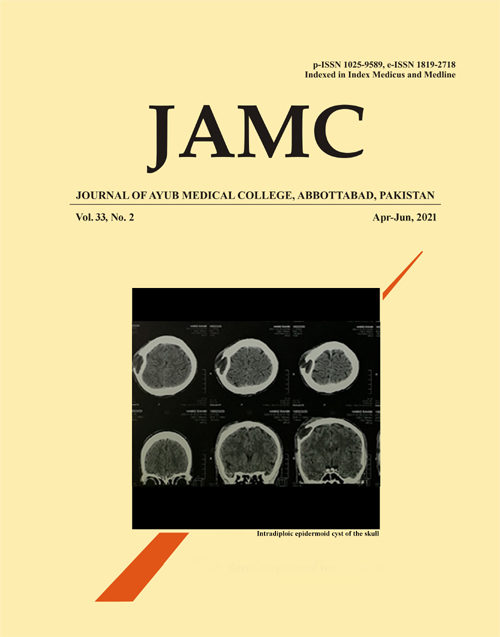AETIOLOGY AND MANAGEMENT OF PRIMARY AMENORRHOEA
Abstract
Background: Amenorrhoea is absence of menstruation. It could be primary, if menstruation has not occurred by the age of 16 years in the presence of normal growth and secondary sexual characters or by the age of 14 years in the absence of secondary sexual characters. It is secondary if periods have not occurred for six months. This study was done with the objective to determine the frequency of etiologic causes of primary amenorrhoea. Study Design: Cross-sectional descriptive study. Methods: The study was conducted in the department of Obstetrics and Gynaecology Sheikh Khalifha Bin Zyed Al Nahyan /Combined Military Hospital Muzaffarabad Azad Jammu Kashmir (SKBZ/CMH MZD AJK) from December 2014 to November 2017. Women with primary amenorrhoea reported and managed in the hospital are included in the study. Cases were analysed according to clinical profile, development of secondary sexual characteristics, physical examination, pelvic and rectal examination, hormonal profile, pelvic ultrasound, magnetic resonance imaging and cytogenetic study including karyotyping. Results: Three most common causes of primary amenorrhoea were Mullerian anomalies (36.7%) followed by gonadal dysgenesis (33.3%), hypothalamic causes (23.3%) and Pituitary causes (6.7%). There were 03 cases of polycystic ovarian syndrome and 02 cases of hyperprolactinemia. Conclusion: The most common etiological factor leading to primary amenorrhoea is Mullerian anomalies followed by gonadal dysgenesis. Genetic and environmental factors could also play role in the causes of primary amenorrhoea.
References
Marc AF, Speroff L. Amenorrhoea. Clinical Gynaecologic Endocrinology and infertility.9th ed. Phildelphia: Wolter Kluwer; (Replica Press), 2015; p.435-93.
Doody KM, Carr BR, Amenorrhoea. Obstet Gynecol Clin North Am 1990;17(2):361-87.
Dutta UR, Ponnala R, Pidugue VK. Chromosomal abnormalities in amenorrhoea: a retrospective study and review of 637 patients in south India. Arch Iran Med 2013;16(5):267-70.
Wachtell SS. The genetics of intrasexuality: clinical and theoretic perspective. Obstet Gynecol 1979;54(6):671-85.
Temizkan O, Kucur SK, Ağar S, Gözükara İ, Akyol A, Davas İ. Virginity sparing surgery for imperforate hymen. J Turk Ger Gynecol Assoc 2012;13(4):278-80.
Opoku BK, Kwarteng RO, Prempeh PA. Transverse vaginal septum with meno uria and unilateral renal agenesis: A case report. Herbert Open Access J Gynecol 2015;3:1-4.
Helmy YA. Cervical agenesis with a functioning uterus: successful surgical treatment by Foley's catheter stent: a case report. Middle East Fertil Soc J 2017;22(1):67-9.
Gottlieb B, Trifiro MA. Androgen Insensitivity Syndrome. In: Adam MP, Ardinger HH, Pagon RA, Wallace SE, Bean LJ, Stephens K, et al., editors. GeneReviews® [Internet]. Seattle (WA): University of Washington, Seattle; 1993 [cited 2020 Jun 27]. Available from: http://www.ncbi.nlm.nih.gov/books/NBK1429/
Leigh B. Gonadal dysgenesis. GynakolGeburtsmed GynakolEndokrinol 2009;5(2):82-94.
Li Y, Pan P, Yuan P, Qiu Q, Yang D. Successful live birth in a woman with resistant ovary syndrome following in vitro maturation of oocytes. J Ovarian Res 2016;9(1):54.
Speroff L, Glass RH, Kase NG, editors. In: Clinical gynecologic Endocrinology and infertility.6th ed. USA: Lippincott Williams and Wilkins; Amenorrhoea, 1999; p.421-76.
Schorge JO, Schaffer JI, Halvorson LM, Hoffman BL, Bradshaw KD, Cunningham FG. Amenorrhea. In: Schorge JO, Schaffer JI, editors. Williams gynecology. New York, NY: McGraw Hill, 2008; p.1112-28.
Reindollar RH, Tho SPT, McDonough PG. Delayed puberty: An update study of 326 patients. Trans Am J Gynecol Obstet Soc 1989;8:146-62.
Reindollar RH, Byrd JR, Mc Donough PG. Delayed sexual development: a study of 252 patients. Am J Gynecol Obstet 1981;140(4):371-80.
Geckinli BB, Toksoy G, Sayar C, Soylemez MA, Yesil G, Aydın H, et al. Prevalence of X-aneuploidies. X-structural abnormalities and 46 XY sex reversalin Turkish women with primary amenorrhoea or premature ovarian insufficiency. Eur J Obstet Gynecol Repord Biol 2014;182:211-5.
Practice committee of the American Society for Reproductive Medicine. Current evaluation of amenorrhoea. Fertil Steril 2008;90(5 Suppl):S219-25.
Committee of Adolescent health care. Committee opinion: no.562: mullerian agenesis: diagnosis, management, and treatment. Obstet Gynecol 2013;121(5);1134-7.
Jyothy A, Kumar KS, Swarna M, Sekhar MR, Devi BU, Reddy PP. Cytogenetic investigation in1843 referral cases of disordered sexual development from Andhra Pradesh, India. Int J Hum Genet 2002;2(1):55-9.
Kumar A, Mittal S. Primary amenorrhoea, analysis of 48 cases. J Indian Med Assoc 1998;96(4):119-20.
Eren E, Saglam H, Cakir ED, Tarim O. Etiological evaluation of adolescent with primary amenorrhoea. Indian J Paediatr 2014;81(9):861-5.
Downloads
Published
How to Cite
Issue
Section
License
Journal of Ayub Medical College, Abbottabad is an OPEN ACCESS JOURNAL which means that all content is FREELY available without charge to all users whether registered with the journal or not. The work published by J Ayub Med Coll Abbottabad is licensed and distributed under the creative commons License CC BY ND Attribution-NoDerivs. Material printed in this journal is OPEN to access, and are FREE for use in academic and research work with proper citation. J Ayub Med Coll Abbottabad accepts only original material for publication with the understanding that except for abstracts, no part of the data has been published or will be submitted for publication elsewhere before appearing in J Ayub Med Coll Abbottabad. The Editorial Board of J Ayub Med Coll Abbottabad makes every effort to ensure the accuracy and authenticity of material printed in J Ayub Med Coll Abbottabad. However, conclusions and statements expressed are views of the authors and do not reflect the opinion/policy of J Ayub Med Coll Abbottabad or the Editorial Board.
USERS are allowed to read, download, copy, distribute, print, search, or link to the full texts of the articles, or use them for any other lawful purpose, without asking prior permission from the publisher or the author. This is in accordance with the BOAI definition of open access.
AUTHORS retain the rights of free downloading/unlimited e-print of full text and sharing/disseminating the article without any restriction, by any means including twitter, scholarly collaboration networks such as ResearchGate, Academia.eu, and social media sites such as Twitter, LinkedIn, Google Scholar and any other professional or academic networking site.










